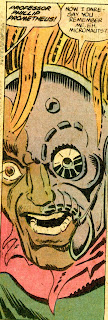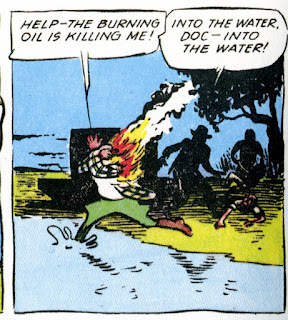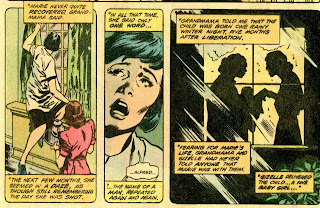Hope developed a sort-of cowardly con artist persona that he played to the hilt in many of his films. So its actually a fun change-of-pace to see him playing a reasonably brave and competent protagonist in 1940's The Ghost Breakers.
Hope plays Larry Lawrence ("My folks had no imagination."), a radio broadcaster who--after some shenanigans in which he thinks he accidentally murdered someone--ends up on a ship sailing to Cuba. Also aboard is Mary Carter, who recently inherited a castle near Havana that's rumored to be haunted. Larry ends up helping Mary, because someone doesn't want Mary to move into her new home and doesn't object to committing murder to stop her. Whether or not there's an actual supernatural element to the proceedings is a part of the mystery.
Mary is played by the mind-numbingly pretty Paulette Goddard. Hope and Goddard had co-starred a year before in The Cat and the Canary, another horror/comedy. The two work well with each other--Goddard is often the straight "man" for Hope, but she's given her fair share of one-liners as well and handles them nicely.
In fact, one of the strengths of The Ghost Breakers is that Goddard isn't just a damsel-in-distress, but also has her share of courage and brains. For instance, she's the one who solves an obscure clue leading to a secret room near the film's climax.
 The combination of mystery, scares and comedy are perfectly balanced. There are one-liners and plenty of slapstick moments, but there's also a real mystery with a logical outcome, some honestly creepy moments and a downright scary zombie played by Noble Johnson.
The combination of mystery, scares and comedy are perfectly balanced. There are one-liners and plenty of slapstick moments, but there's also a real mystery with a logical outcome, some honestly creepy moments and a downright scary zombie played by Noble Johnson.Hope's assistant is played by African-American comedian Willie Best. Like Mantan Moreland & Stepin Fetchet, Best is a figure of some controversy today. Jump over to his IMDB page to read some of the comments. Or rather, don't do that. It's the Internet--you won't find rational discussion there.
Best was a brilliant comedic actor, working in an era where most of his roles played on black stereotypes. But there's no denying that he was hilarious--Hope later called him "the best actor I know." For me, I think actors such as Best, Moreland and Fetchet should be appreciated and enjoyed for their obvious skill at making people laugh. Their ability to make us laugh is such that we sincerely like them and never laugh "at" them, if you see what I mean.
 At the same time, I recognize that the type of roles they had were often intended to be safe and non-threatening to the racial status quo of the day. So if someone else cringes at Best's performance and doesn't find anything to laugh about, then I'm not at all critical. It's yet another situation where it's not a matter of being politically correct or incorrect, but simply reacting to the performances on an individual basis and respecting the opinions of others.
At the same time, I recognize that the type of roles they had were often intended to be safe and non-threatening to the racial status quo of the day. So if someone else cringes at Best's performance and doesn't find anything to laugh about, then I'm not at all critical. It's yet another situation where it's not a matter of being politically correct or incorrect, but simply reacting to the performances on an individual basis and respecting the opinions of others.I recorded a clip of the movie to share here, but I guess Paramount Pictures is (like Universal) one of the big-meanie studios that tells YouTube to block clips. I'm all for intellectual rights, so (though I think short clips should qualify as Fair Use) I don't question Paramount's right to control their content. It's a silly decision, though, since such clips are essentially free advertising. Oh, well--there's no accounting for lawyers, I guess. At least Warner Brothers is cool about such things.
Here, at least, is the trailer:
























































